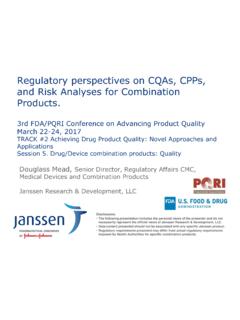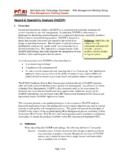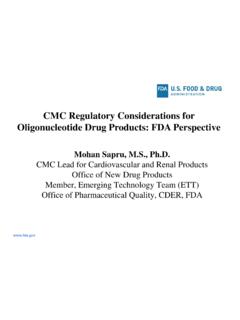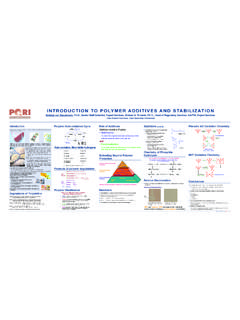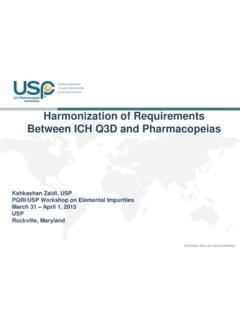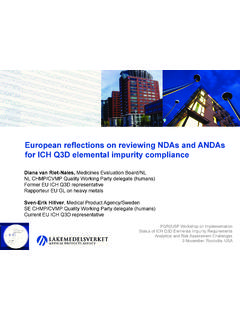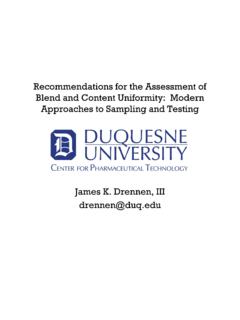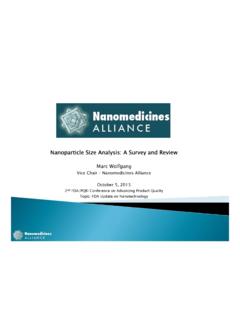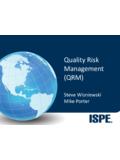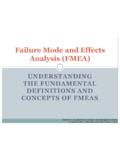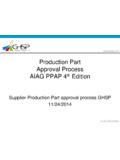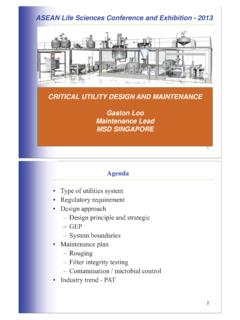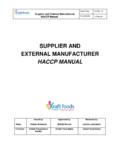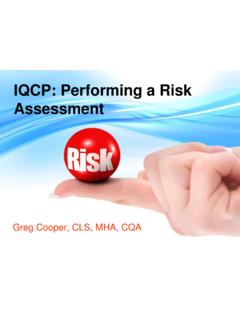Transcription of Failure Modes and Effects Analysis Guide
1 Manufacturing Technology Committee Risk Management Working Group Risk Management Training Guides Failure Modes and Effects Analysis Guide 1 Overview Failure Modes and Effects Analysis (FMEA) is commonly used in a variety of industries for Risk Management, where simple quantification of risk is insufficient, and where identification of root causes of risks and means of mitigation are paramount. FMEA is one of the most useful and effective tools for developing designs, processes and services. The goal of FMEA is to align the risks as closely as possible with its source. This enables the determination of the root cause of the risk, and allows the selection of ways to detect the occurrence of a particular Failure and/or to find options to prevent or mitigate the Effects of a particular Failure .
2 Good FMEA methodology allows for the identification and documentation of potential failures of a system and their resulting Effects . It also allows for the assessment of the potential Failure to determine actions that would reduce severity , reduce occurrence , and increase detection . During FMEA, all steps are analyzed for potential Failure opportunities; the ultimate effect to product quality or patient safety and/or efficacy as a result of each potential Failure opportunity is then quantified; and then adjusted based on capabilities to detect or mitigate, to reach a final assigned score of The risk for each Failure is often times entered into a risk score matrix which enables easy determination of the priority and/or level of attention required to be applied to each step based on its total risk priority number (RPN).
3 The outcome of the FMEA is a list of recommendations to reduce overall risk to an acceptable level, and can be used as a source for designing a control strategy. This document presents guiding principles for the execution of Failure Modes and Effects Analysis (FMEA). Successful application of any risk management model requires that the tools are used in concert with an overall quality risk management process, similar to that described by ICH Q9. Use Failure Modes and Effects Analysis can be a useful tool in: selection and optimization of drug product formulation defining the design space for manufacturing processes for drug substances and drug products design and manufacture of devices Training Guide : Failure Modes and Effects Analysis Guide A list of advantages and disadvantages of the FMEA tool is provided as follow: Advantages Disadvantages - Accepts a high degree of complexity.
4 - Requires significant effort in - Uniform quantification of risk can be establishing clearly defined terms. applied. - Requires significant effort in assigning - Results can be correlated directly with scores to each step. actual risks. - The effect of various methods of mitigation/ detection on risk can be modeled easily. - Provides a well-documented record of improvements from corrective actions implemented. - Provides information useful in developing test programs and in-line monitoring criteria. - Provides historical information useful in analyzing potential product failures during the manufacturing process. - Provides new ideas for improvements in similar designs or processes. 2 Risk Assessment Define Goal of Risk Assessment The first step in any risk assessment is to define the goal of the risk assessment.
5 Components of the FMEA are: severity : if a Failure were to occur, what effect would that Failure have on the product quality and on the patient (if any)? Probability of occurrence : how likely is it for a particular Failure to occur? Detectability: what mechanisms are in place (if any) to detect a Failure if it were to occur? Each of the above metrics require clear definitions and a corresponding scale to rank or score the projected impact ( a scale for severity ; a scale for Probability; and a scale for ability to Detect).. In addition, a composite score would then need to be calculated ( severity multiplied by Proabality multiplied by ability to detect ) and matrixed so that final team recommendations are based on a calculated and unambiguous fashion.
6 Page 2 of 10 Date: May 29, 2008. DRAFT PROPOSAL NOT FOR IMPLEMENTATION Revision: 04. Training Guide : Failure Modes and Effects Analysis Guide Define overall process and process increments (unit operations, steps) FMEA Team Start-Up Initiation of a FMEA requires the assembling of a a facilitator, team lead and person team usually comprised of a facilitator, a team lead, responsible for taking minutes and maintaining and functional experts from development, records the scope of the FMEA. Include a clear ,manufacturing, quality, regulatory, etc., as definition of the product or process to be studied. appropriate. The assembled team should first team members. Ensure that al keyl describe the process in general unit operations, and impacted functional areas are represented, then section each unit operation into its component development, manufacturing, quality, regulator, parts.
7 Use of a detailed flow chart of the process or etc. 4. Ensure that the necessary range of knowledge schematic of the design under evaluation is and experience are represented on the teams( recommended. It is also important that team is it necessary to have a skilled operator from members gain input from key stakeholders who will manufacturing involved instead of only engineers be responsible for implementing any resulting or scientists?). recommendations to ensure feasibility. FMEA Team's boundaries of freedom - What aspect of the FMEA is each team/ subteam Sectioning of the unit operation should be done in responsible for ? FMEA Analysis , process increments of sufficient size to enable recommendations for improvement, implementation of improvements, accurate risk assessment for each unit operation and 6.
8 Also define project deadline, team member in turn the entire manufacturing train. It is critical to time constraints, etc. to ensure all are preparted describe each step in sufficient detail so that the to support the initiative. team members have team can adequately assign the proper risk score to specific time constraints? the step. Careful attention to detail is needed so that 9. What is the procedure if team needs to expand beyond the established boundaries? common practices that affect risk are captured in the should the FMEA be communicated step description. While these additional levels of to others? detail provide greater accuracy, they also require greater effort. The appropriate level of detail is a matter of judgment for each team and depends on the perceived overall significance of the project and the corresponding risk involved; for example introduction of a new technology versus an established core competency.
9 Establish Clear Definitions FMEA. As indicated in Section , risk in an FMEA evaluation has three components: severity , Probability, and Is dependent on a complete sectioning of the overall risk into risks associated with Detectability. The definitions for the various levels of the smallest increment step in the severity , probability, and detectability should be clearly process. articulated. Examples of definitions for each level are Requires an agreed-upon set of clearly presented in the tables below. For each of these risk defined terms for the component parts of profile attributes, a five-point rating scale was risk ( severity , probability, and developed and utilized to ensure that the risk rating had: detectability), and the corresponding appropriate levels of differentiation in order to scores.
10 Support meaningful risk prioritization Provides a means to determining the level of attention to be applied to each clearly apparent meaning in the context of the step, and summarizes recommendations overall risk to process and product quality to reduce the risks. at each step Page 3 of 10 Date: May 29, 2008. DRAFT PROPOSAL NOT FOR IMPLEMENTATION Revision: 04. Training Guide : Failure Modes and Effects Analysis Guide consistency across the risk profile attributes ( severity , occurrence and detection ) to ensure that no attribute contributed disproportionately to the overall prioritization of risk. It is important to note that the definitions, levels and numbers assigned to the different levels can vary depending on the system under evaluation or previously established definitions by the organization or company.
